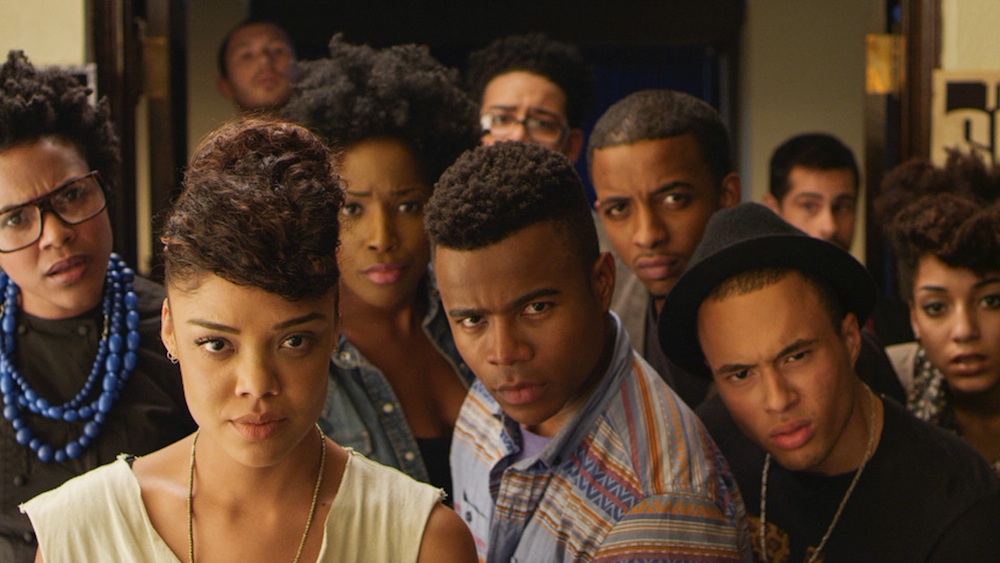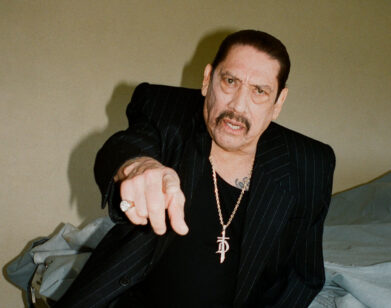Justin Simien’s Open Letter

ABOVE: TESSA THOMPSON (FRONT LEFT) IN JUSTIN SIMIEN’S DEAR WHITE PEOPLE
Justin Simien’s Dear White People, the satire that he wrote, directed, and premiered at Sundance last week, is punctuated with pithy transmissions from one of his characters’ YouTube channels: “Dear white people, dating a black person to piss off your parents is a form of racism;” “Dear white people, the number of black friends required to not seem racist has officially been raised to two;” “Dear white people, please stop dancing.”
Sam, played by Tessa Thompson, intones these messages in a deadpan. She’s something of a cult figure in the politically black community at her Ivy League college, but she is not without her detractors. Teyonah Parris’s Coco, a black student whose vlog hasn’t found the same online infamy as Sam’s, calls her a “blacker-than-thou Lisa Bonet wannabe who smells like patchouli oil,” and insists that her “boycotting hair combs doesn’t make her an expert on colored people.” Coco is more interested in entering the white establishment than tearing it down, and the tension between her and Sam’s political praxes runs strong throughout the film as a series of offensive events unfold on campus. Other key players include Troy (Brandon P. Bell), the wealthy son of the college’s dean of students, whom Sam overthrows as head of the black students’ house, and Lionel (Tyler James Williams), the nerdy reporter who covers events at that house for the school paper, but doesn’t feel black enough to actually participate in them.
A film like Simien’s—one that looks at these nuances in young black American identity—is overdue. As much was evident in the overwhelming response he received when he launched the project’s Indiegogo campaign in 2012. He raised almost double his $25,000 goal, but that would hardly suffice to fund a feature film. More than anything, the campaign acted as much-needed evidence to labs and production companies that an audience for a film like this—underrepresented and eager to see themselves onscreen—actually existed.
ZACK ETHEART: Where did you go to school?
JUSTIN SIMIEN: I went to to a school called Chapman University, which is a wonderful film school. It was a great program, but it was very white, and it was a culture shock for me because I grew up in Houston, Texas, and I went through what they call magnet schools, so my friends were like a Benetton ad. [laughs] I literally had a friend of every race in my group, and to go from that to white as can be, white as snow? It wasn’t even that it was white, it was people who had not had a lot of interaction with people of other cultures, whatever that culture may be. And that’s where it started. But really, Winchester [University] in Dear White People is not Chapman. Winchester really came about after I started to research black experiences at Ivy League colleges. I thought an Ivy League setting would be a more interesting world to put the story in. When I started to research some of the things that had gone on at those schools, that really is when the version that made it to Sundance started to click into place.
ETHEART: One of my favorite moments in the film is when Coco is talking about her reality TV aspirations and she says, “I just want people to know my name.” And when someone asks her which name, Colandrea or the less “ghetto” Coco, she pauses for a moment and she looks really unsure.
SIMIEN: I think all of the characters in the film are kind of going through an identity crisis, and I think that when you are a person who is different, and that could be anything—that could be gay, or a woman, or of a certain religious background, or whatever it may be—when you are different from the majority around you, there is a sort of sense of needing to kind of wear the mask that is most acceptable. It’s almost like there is a pressure to feel accepted for what they want you to be as opposed to who you are, and I thought that it would be interesting to have this character who was basically just constantly modulating as to whatever the best opportunity was, and not even to really blame her for it, not to make her bad for doing it, but just to show what really happens, because it does feel like a survival tactic. You know, “How do I survive in this place?” And I thought that was a really interesting way to say that with her. The way she changed her name—that is a very common thing, too, in these situations and particularly in Hollywood for actors who have very ethnic names. The idea that I’m famous for a name that I wasn’t born with and that I haven’t identified with for most my life—I just thought that was so interesting.
ETHEART: Do you think it’s true that Hollywood only sells black films about misery or minstrelsy?
SIMIEN: That’s exactly what it is. I don’t want to get myself in trouble when I say this, but it is true. I think part of it is that a mainstream audience will go see a “misery” film. When I say “mainstream,” I mean outside of just black people, because I think tragedy allows someone to feel a sense of empathy. And you can sort of like pat yourself on the back, because you feel like maybe you contributed to or helped the situation if you saw it. People say that it’s a white guilt factor, and I think that part of that is a little true. But if we want to talk about 12 Years a Slave or Fruitvale or something like that, those films are fucking brilliant and everyone should see them and talk about them. But it has become this thing where every year there’s always the black movie about either the inner-city kid or someone in the Civil Rights era that just had it “really bad.” I think people feel obligated to see it.
ETHEART: Do you find that it’s a struggle to break out of that mold? Or to resist the temptation to make a super-palatable representation of blackness?
SIMIEN: I think what you’re talking about is what we black artists have been talking about since the Harlem Renaissance. Do you put out the stuff where every black person is pristine and perfect and educated and smart? Or do you tell the truth and admit that sometimes the truth involves black people that live up to the stereotype? I lean on the side of the truth. I think art is much more valuable when it’s honest. If it’s not honest, it’s just propaganda. If I just wanted to put clean, perfect images of black people on the screen for an hour and a half, first of all, there are other people already doing that, and they’re making a lot of money doing it. I get it, you do want to fight the stereotype, but again, I just lean back on the fact that there are some movies about race that don’t tell the truth. They tell us what we already know: that racism is wrong and that black people are wonderful and that they deserve a chance. To me that’s boring. It doesn’t say anything new, it doesn’t incite change and it doesn’t incite conversation. A movie like Do the Right Thing (1989), for instance, does that because it tells the truth. All the characters are flawed. They all contribute to Radio Raheem’s death in small and big ways. That’s the kind of art that I’m into, the stuff that tells the truth. People like Langston Hughes who now we revere as a master—at the time, people were very upset because he was portraying black people in a realistic ways. That did not always suit the demands of, say, the NAACP, or the image that they wanted to put out there to white America. But look what won out.
ETHEART: Are there any recent movies or series currently that you think are doing that?
SIMIEN: It is really happening on the web. Stuff like Awkward Black Girl, Shit Black People Say—when that was hot. It’s not anymore, I guess. I think all of those things speak to it. I think the web is a great place for that. Key and Peele are doing it. The Chappelle Show did it really well. Boondocks was doing it. I think it is kind of happening on TV and the web a lot more. Hopefully movies can catch up.
For more from Sundance 2014, click here.






